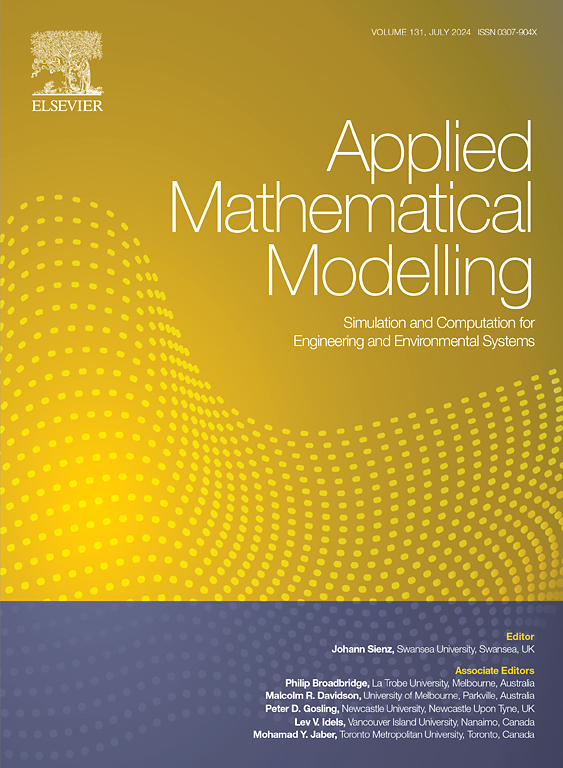Modeling salmonellosis transmission dynamics in humans and dairy cattle with optimal controls
IF 4.4
2区 工程技术
Q1 ENGINEERING, MULTIDISCIPLINARY
引用次数: 0
Abstract
In this paper, we develop a mathematical model to examine the transmission dynamics and control analysis of salmonellosis in humans and dairy cattle. The model considers three time-dependent controls (improving hygiene, vaccination, and organic acid disinfectants), human and dairy cattle populations, and Salmonella typhimurium bacteria in the environments and dairy products. The next generation matrix technique is applied to compute the effective reproduction number that gauges the persistence and extinction of salmonellosis while adopting the proposed control interventions. The stability behavior of the equilibrium states is examined using the Lypunov function method based on the effective reproduction number . The Latin hypercube sampling and the partial rank correlation coefficient methods are used to investigate the sensitivity and uncertainty of input parameters against model outputs. The results indicate that improving hygiene and vaccination can eliminate salmonellosis. Improving hygiene habits at a rate of at least 0.9 per day is recommended to eliminate salmonellosis. An efficacious vaccine that can immunize at least 85% of the vaccinated dairy cattle is also recommended to eradicate salmonellosis if it can be implemented to vaccinate susceptible dairy cattle at a rate of at least 0.45 per day for the first 30 days of the salmonellosis outbreak. The use of all three controls is recommended to eliminate salmonellosis quickly and at the lowest cost.
用优化控制模拟沙门氏菌病在人类和奶牛中的传播动态
在本文中,我们建立了一个数学模型来研究沙门氏菌病在人类和奶牛中的传播动态和控制分析。该模型考虑了三种随时间变化的控制措施(改善卫生条件、疫苗接种和有机酸消毒剂)、人类和乳牛种群以及环境和乳制品中的鼠伤寒沙门氏菌。应用下一代矩阵技术计算有效繁殖数 R,以衡量在采用建议的控制干预措施时沙门氏菌病的持续性和灭绝性。利用基于有效繁殖数 R 的 Lypunov 函数方法对平衡状态的稳定性进行了检验。利用拉丁超立方采样和偏等级相关系数方法研究了输入参数对模型输出的敏感性和不确定性。结果表明,改善卫生习惯和接种疫苗可以消除沙门氏菌病。建议以每天至少 0.9 的速度改善卫生习惯,以消除沙门氏菌病。如果能在沙门氏菌病爆发的前 30 天内,以每天至少 0.45 次的速度为易感奶牛接种疫苗,则还建议使用能使至少 85% 接种疫苗的奶牛获得免疫的高效疫苗来消灭沙门氏菌病。建议采用所有三种控制措施,以最低成本迅速消灭沙门氏菌病。
本文章由计算机程序翻译,如有差异,请以英文原文为准。
求助全文
约1分钟内获得全文
求助全文
来源期刊

Applied Mathematical Modelling
数学-工程:综合
CiteScore
9.80
自引率
8.00%
发文量
508
审稿时长
43 days
期刊介绍:
Applied Mathematical Modelling focuses on research related to the mathematical modelling of engineering and environmental processes, manufacturing, and industrial systems. A significant emerging area of research activity involves multiphysics processes, and contributions in this area are particularly encouraged.
This influential publication covers a wide spectrum of subjects including heat transfer, fluid mechanics, CFD, and transport phenomena; solid mechanics and mechanics of metals; electromagnets and MHD; reliability modelling and system optimization; finite volume, finite element, and boundary element procedures; modelling of inventory, industrial, manufacturing and logistics systems for viable decision making; civil engineering systems and structures; mineral and energy resources; relevant software engineering issues associated with CAD and CAE; and materials and metallurgical engineering.
Applied Mathematical Modelling is primarily interested in papers developing increased insights into real-world problems through novel mathematical modelling, novel applications or a combination of these. Papers employing existing numerical techniques must demonstrate sufficient novelty in the solution of practical problems. Papers on fuzzy logic in decision-making or purely financial mathematics are normally not considered. Research on fractional differential equations, bifurcation, and numerical methods needs to include practical examples. Population dynamics must solve realistic scenarios. Papers in the area of logistics and business modelling should demonstrate meaningful managerial insight. Submissions with no real-world application will not be considered.
 求助内容:
求助内容: 应助结果提醒方式:
应助结果提醒方式:


